25,000 Python Devs Surveyed on Tools, IDEs and Python 2

Developer tool provider JetBrains and the Python Software Foundation have surveyed 25,000 Python developers, and after six months of crunching and collating data — over 34 MBs worth — the final results have been released.
The survey is an annual tradition, and a grand event, where the Python community gets to see itself from a larger perspective — and then ponder what it all means.
Are You Experienced?
The survey first asked who was answering its questions.
The methodology specifies filtering out anyone who didn’t answer the question “How many years of professional coding experience do you have?” on the third page of the survey, as well as anyone who said they were 17 or younger.
And you were also halfway to being filtered out if you selected “CEO” as your role while giving an age under 21.
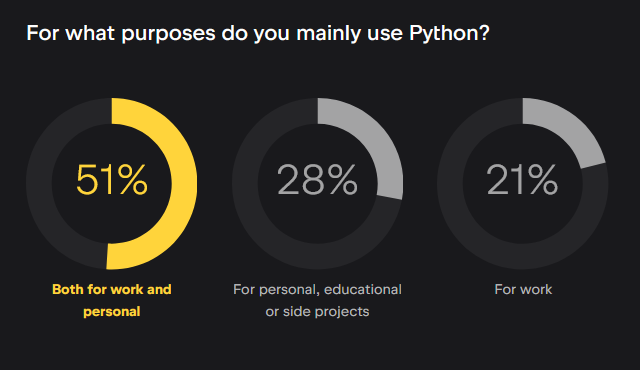
To ensure they reached Python developers, surveyors reached out through official Python Software Foundation channels, including python.org, Python’s mailing lists, the PSF blog, LinkedIn, X accounts and Python subreddits.
Results came from last November through February 2024 — a longer window than usual “to facilitate as much global representation as possible.” Responses flowed in from nearly 200 different countries and regions — just 20% from the United States, the largest demographic, followed by 9% coming from India.

And while the “gender” question was optional, 87% of those who did respond chose “male.” Another 8% chose “female,” with 3% more choosing “prefer not to say” and 1% choosing “non-binary, genderqueer or gender non-conforming.”
It’s an interesting glimpse into one of the largest developer communities, especially since the 25,000 developers surveyed shared not only how they’re using Python, but also the other tools they’re using at the same time.
The Other Tools
For example, the most popular IDEs were Visual Studio Code (22%), Jupyter Notebook (20%, with Jupyter Lab at 12%), Vim (17%), and PyCharm Community Edition (13%) and PyCharm Professional Edition (7%).
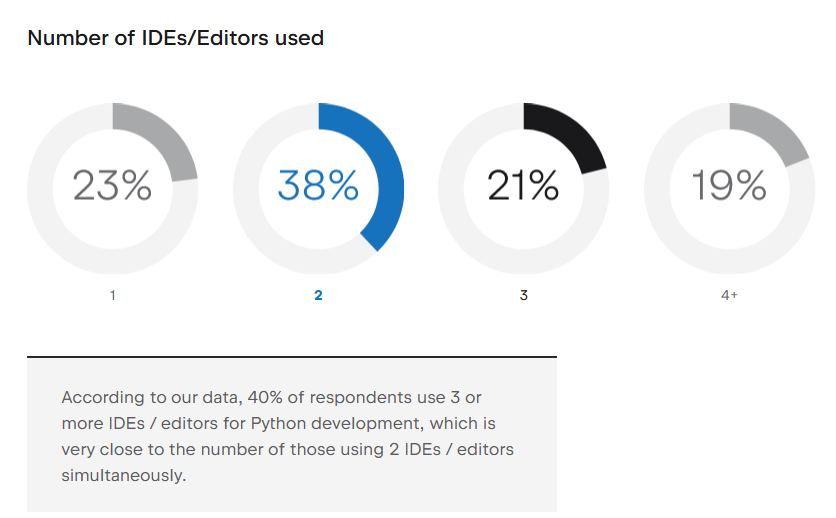
In fact, just like last year, 85% of respondents said that Python was their main language. And while 25% of respondents said they’d published to a package repository, the survey also found that 16% of Python developers are building speedy pre-compiled binary modules (for importing into other Python programs) using other programming languages.
Also, 55% said they were coding Python modules in C++ (with another 44% using C), but a full 36% had turned to a memory-safe language like Rust (27%) or Go (9%).
Respondents could choose more than one answer, so it was interesting to see which other languages attracted clusters of Python module developers. After the 7% who were using C#/.NET, there was another 5% who said they were using Fortran and 3% who were using Assembly.
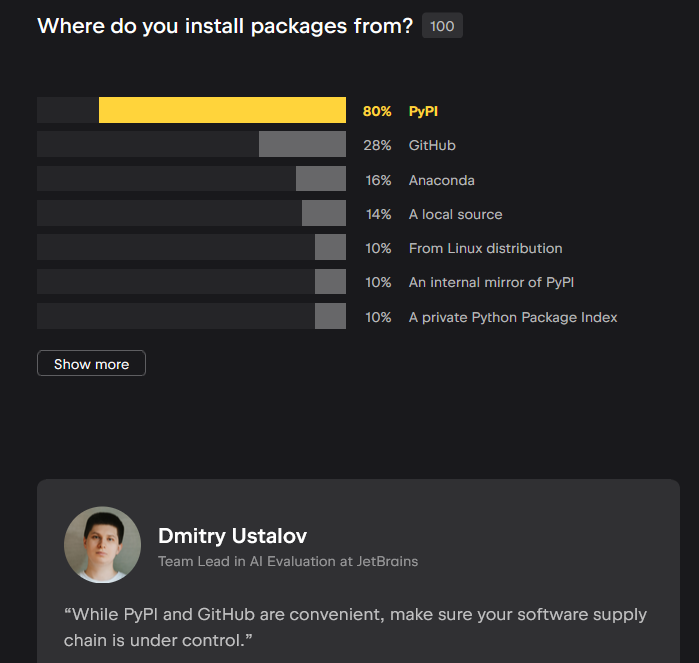
There was another surprise in a question about Python’s use with other languages. It found a small but steady drop in JavaScript’s use with Python over the last three surveys — from 40% (2021) to 37% (2022) to 35% (2023-2024).
And there was a similar drop for the HTML/CSS choices, going from 38% (2021) to 36% (2022) to 32% (2023-2024).
The official results include this observation from Paul Everitt, JetBrains’ web/data advocacy team lead: “The drop in HTML/CSS/JS might show that data science is increasing its share of Python.”
Data about Data Scientists?
But then what to make of a “usage” question where Python’s use for data analysis fell from 51% in 2022 to just 44% in the latest survey? TNS analyst Lawrence Hecht suggested survey respondents were just focusing on fewer user cases in their answers. Hecht points out that “they were also asked which is the most commonly used Python use case, and data analysis fell off the cliff, going from 18% in 2022 to 10%.”
Hecht’s conclusion? “Overall, fewer Python users are classifying themselves as a data analyst, and even the data analysts are much less likely to say that their primary Python use case is analysis.”
Forty-five percent of the survey’s respondents also said they used Kubernetes for running code in containers.
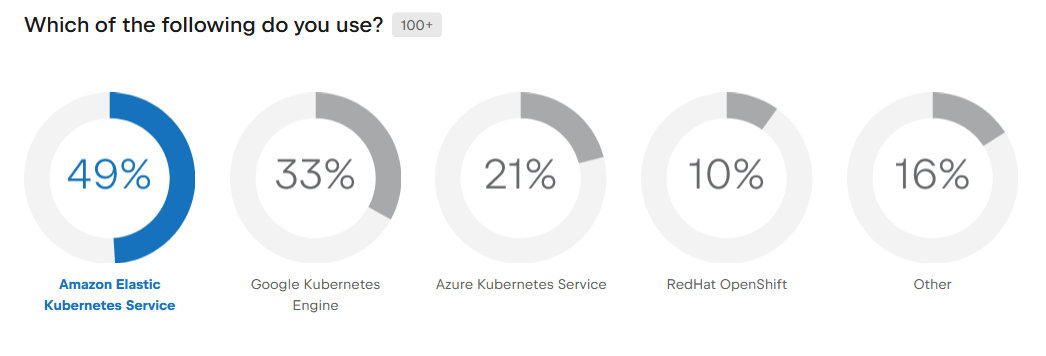
Indeed, 2022’s survey had asked point blank: Do you consider yourself a data scientist? Thirty-four percent answered “yes” (with 61% saying “no” and another 5% choosing “other”). The latest survey, with a slightly broader question, reports that 48% of all surveyed Python developers are still “involved in data exploration and processing.”
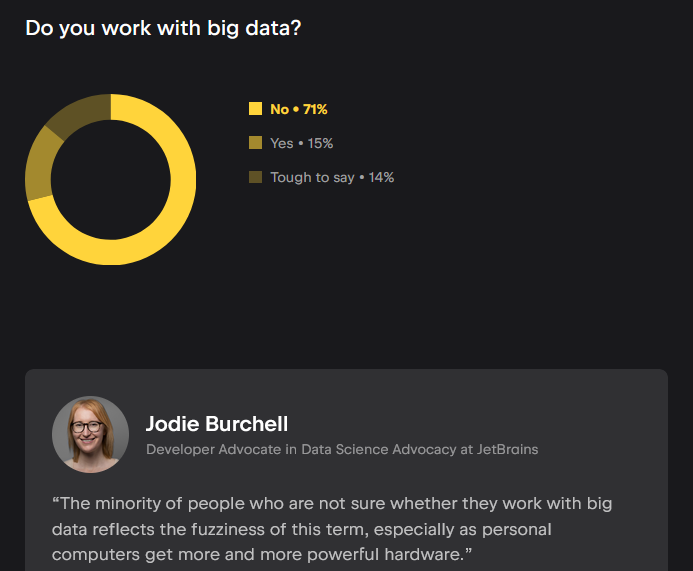
On the other hand, when asked for their job role, fewer respondents chose web developer (62%) than in previous surveys (65% in 2022, 72% in 2021, 73% in 2019.)
And in response to the question, “What do you use Python for the most,” there’s also been a consistent drop for “web development” every year since 2018.
- 29% (2018)
- 28% (2019)
- 25% (2020)
- 23% (2021)
- 22% (2022)
- 21% (2023-2024)
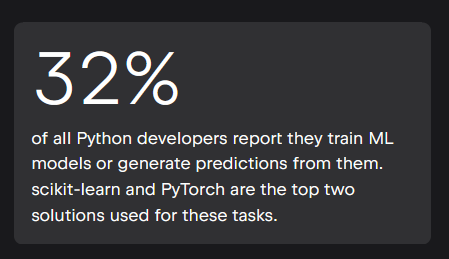
Age and Python
TNS analyst Hecht also points out that the respondents were older, a trend which has accelerated since 2020, when 50% of respondents had said they were between 18 and 29 years of age.
In 2021 that number dropped to 48%, and then to 46% in 2022, finally arriving at 40% in the latest survey. (Meanwhile there’s been an increase in respondents choosing “30-39” for their age range — from 29% in 2021 to 31% in 2022 and then 33% in this year’s survey.)
Age may also be a factor in another interesting result. Even though Python 2 reached “end-of-life” status in the spring of 2020, this year’s survey found 6% of respondents were still using Python 2, down from 7% in the last survey.
“Almost half of Python 2 holdouts are under 21 years old,” the survey results noted, “and a third are students. Perhaps courses are still using Python 2?”
Python is a popular choice for beginning programmers, and the survey seems to bear this out. Forty-nine percent of respondents also had less than two years of programming experience, according to the survey, with 33% choosing “less than 1 year” and 16% saying “1-2 years.” Sixteen percent also said they’d been programming in Python specifically for one to two years.
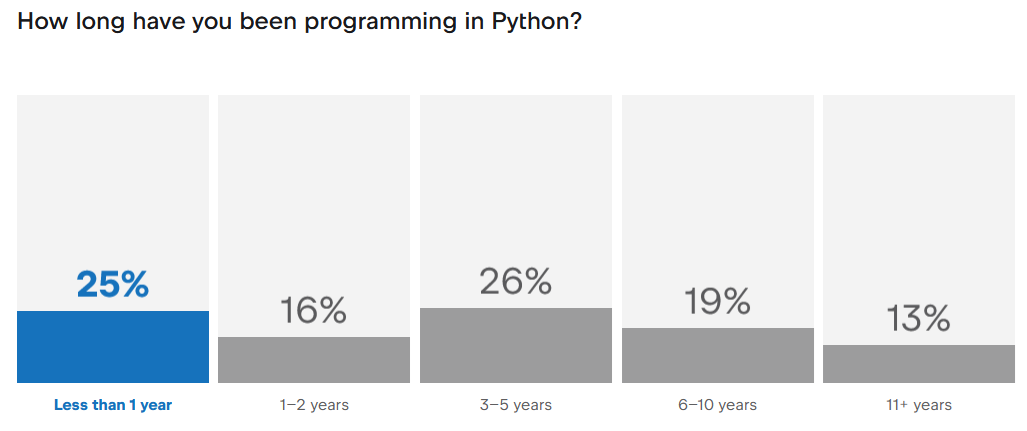
And while 62% of respondents said they were “fully employed by a company,” the next-largest category was “student” (12%), with another 5% choosing the option “working student.” Others chose “self-employed” (6%), “freelancer” (6%), “partially employed by a company” (4%), and unemployed (4%). Another 1% chose “retired.”
When Data Science Meets Web Development
Among Python developers, the survey found, web frameworks “are used widely, including by 77% of data scientists and 97% of web developers.” Interestingly, Flask, the top framework, saw high usage among both web developers (42%) and data scientists (39%). And there were similar high marks for FastAPI, used by 46% of web developers and 31% of data scientists, a fact noted by Vladimir Sotnikov, the development lead at JetBrains, in the survey’s official results.
“While ML developers are less likely to use Django, a framework favored for full-scale web app development, their engagement with Flask and FastAPI, both suited for building RESTful APIs, is nearly as high as that of web developers,” he wrote. “This suggests that ML professionals are actively involved in web development — but primarily through API-driven services rather than traditional website creation.”

There were also statistics on how Python developers run code in the cloud. And the numbers seemed to square with other surveys, according to Mukul Mantosh, a JetBrains’ data developer advocate
“Based on the Cloud Native Computing Foundation survey of 2022, approximately 44% of users have transitioned most of their production workloads into containers, with an additional 9% still in the evaluation phase,” he wrote.
Interestingly, usage seemed to be increasing for nearly all the major cloud platforms.
We found the results out of the 2023 Python Developers Survey interesting and satisfying. #pythondevsurvey pic.twitter.com/CziWMOAmPM
— PythonAnywhere (@pythonanywhere) August 30, 2024
But in the end, Python’s security developer Seth Larson was especially proud of one particular result.
Per the latest #Python Developers Survey:
37% of respondents said they’d contributed to an open source project in the past year! 🤯
This is an incredible result for #Python, open source relies on folks contributing back so I am feeling hopeful for our ecosystem 😊 https://t.co/tyaFcyZJaU
— Seth Michael Larson (@sethmlarson) August 29, 2024
And there was even a detailed breakdown about exactly how they’re doing it:
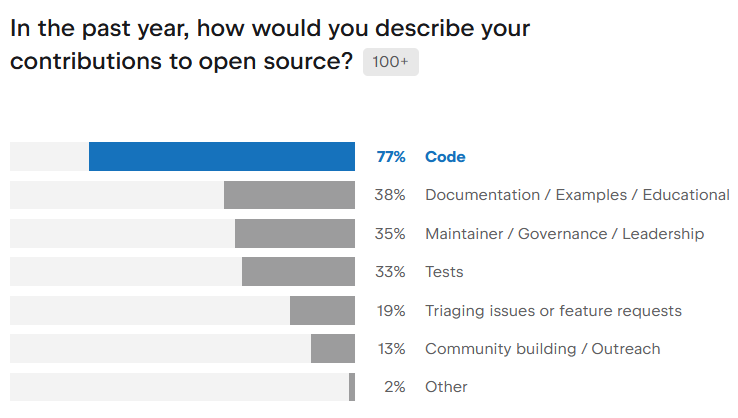
Maybe it augurs more good things to come — an oddly inspiring piece of good news that arrived thanks to 2024’s Python Developer’s Survey.
And to the 25,000 developers who contributed their time to answer it.
